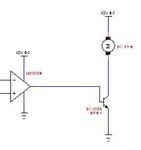kikikrunch
Newbie level 4

Hi, I would like to enquire on the following circuit. Something which I don't understand about the BJT. The circuit op amp is a PWM output.
I understand that if I put a resistor Rb, it will control the amount of current provided to the DC Fan. However, if I didn't put a resistor Rb, the circuit works too. What I don't understand is that, is it necessary to put a resistor Rb when working with PWM output?
Some specifications
PWM output range 5.5V to 8V
DC Fan maximum 12V @ 0.16A

